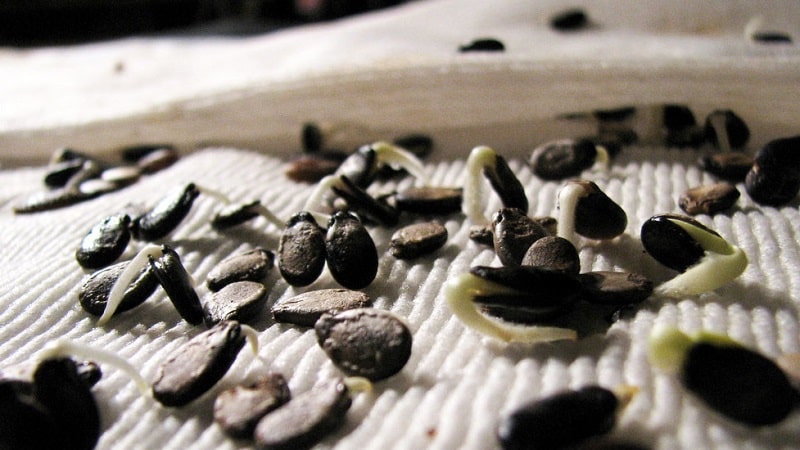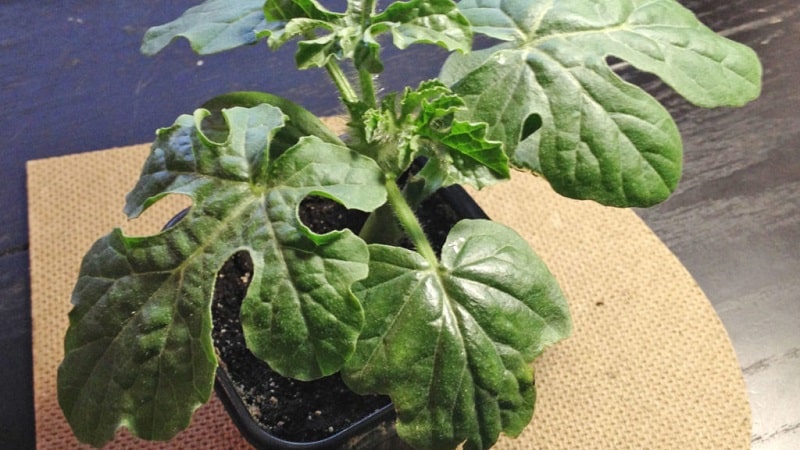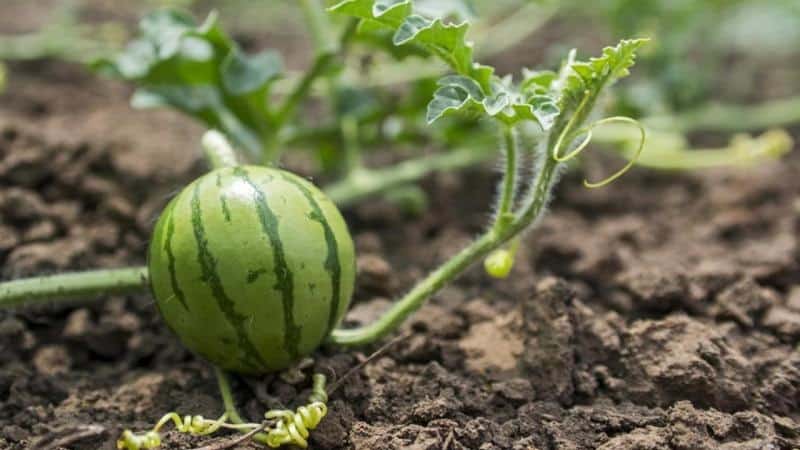How to germinate watermelon seeds correctly and what to do next with the finished planting material
Many people associate hot and sunny summer with the taste and aroma of juicy, sweet, sugary watermelon. It’s not difficult to grow it in your garden if you know a few tricks. Thus, proper germination of seeds not only activates the process of their growth, but also helps to increase germination. In this article we will reveal all the important nuances of preparing watermelon seeds for planting.
Is it necessary to germinate
Watermelon is characterized by high intensity of growth processes. At a temperature of 25-35ºС and sufficient soil moisture, the time from planting to germination is about 10 days.

However, for central Russia it is not typical such temperature values, especially in April-May. It will take a long time for sprouts from ungerminated seeds to emerge.
Germination is a simple and inexpensive technique to obtain an earlier harvest of watermelons.
Benefits of the procedure
Sprouting provides benefits in growing a heat-loving crop such as watermelon:
- germination will be almost one hundred percent - you can select the strongest seedlings for planting.
- seedlings appear together - it is easier to care for seedlings when all plants are at approximately the same stage of development.
- The harvest date comes 1-2 weeks earlier.
It will be interesting:
The benefits of watermelon juice and how to prepare it correctly
How to germinate watermelon seeds
For planting on a summer cottage it is better to use zoned early or mid-ripening varieties and hybrids.
The germination procedure consists of several stages, each of which should strictly adhere to the recommendations.
Stage 1: verification
Strong and full seeds are selected for germination no damage or signs of deterioration (mold, stains).
To check the quality of seed material conduct a small test: 1 tbsp. l. table salt is dissolved in 0.5 cups of water, seeds are placed in the solution, those that float are thrown away. For further work, take watermelon seeds that have fallen to the bottom. They are washed with clean water and dried.
Stage 2: preparation
Preparation for germination includes several procedures:
 Calibration. Planting material is sorted into groups by size. Germination and emergence of seedlings in each group will be more friendly.
Calibration. Planting material is sorted into groups by size. Germination and emergence of seedlings in each group will be more friendly.- Etching. Disinfection is carried out with a 2% solution of potassium permanganate: 1 tsp. without top, dilute in 300 ml of water at room temperature. The seeds are placed in the solution for 20 minutes, then washed with running water. If the manufacturer of the planting material has carried out dressing (there is a warning about this on the packaging or the seeds are painted in a bright color), this procedure should be excluded.
- Treatment with growth stimulants. This is an optional procedure, but to speed up germination and additionally saturate the sprouts with nutrients, you can use one of the preparations: potassium humate, Heteroauxin, Epin, Zircon. It is important to strictly follow the manufacturer's instructions. After treatment with stimulants, there is no need to rinse the seeds with clean water, just dry them.
- Scarification — violation of the integrity of the membranes to facilitate sprout pipping.Using fine-grit sandpaper, lightly grind down the nose of the seed. You need to act carefully so as not to damage the embryo.
Stage 3: germination
Prepared seeds are soaked before germination for 10 minutes in hot (45-50ºС) water to soften the thick peel.
Lay out, leaving space between the bones, on several layers of damp gauze. The workpiece is placed in a shallow flat dish and left in a room with a temperature of 20-30ºС. The gauze should be checked and moistened regularly. Planting material should always be on a damp substrate, but not floating in water.
Reference. To reduce the rate of moisture evaporation and create more favorable germination conditions, the container can be covered with film.
How many days do soaked seeds germinate?
Watermelon seeds soaked according to all the rules will hatch in 5-7 days. The appearance of sprouts may be delayed if there was no prior soaking in hot water. Low temperatures can also slow down the germination rate.
The germination time of germinated seeds may vary depending on temperature and soil moisture. Shoots appear on average 10 days after planting. If the weather is warm, the sprouts will rise above the ground a little earlier.
What to do if there are no sprouts
Seed material may not germinate if:
- The seeds are old and not germinating. In this case, you need to purchase fresh ones and carry out all the procedures again.
- Temperature not maintained. Perhaps the seeds are not getting enough heat. We need to move them to a more suitable location.
- Scarification and soaking were not carried out in hot water. You need to wait until the sprout breaks through the thick shell.
- Not enough moisture. Perhaps the gauze with planting material periodically dries out, so you need to check and moisten the watermelon seeds more often.
It can be useful:
Simple and effective watermelon masks for face and hair
How to prepare delicious and healthy watermelons in your own juice
How to plant sprouted seeds
As soon as the seedlings reach 1-1.5 cm in length, they can be planted in the ground.
Watermelons are usually grown using seedlings.. If weather conditions permit, you can plant the seeds directly in open ground.

Planting seedlings
Watermelons are suitable substrate for cucumbers, which is sold in specialized stores. It’s easy to prepare the soil yourself: mix sand, turf soil and humus in equal parts.
Small containers are used to grow seedlings approximately 10 cm in diameter.
Pots are filled with soil, spill with water, make a hole 3 cm deep. Place a seed in the hole and sprinkle with earth.
The container is covered with film and kept at a temperature not lower than 25ºСuntil shoots appear. Then the film is removed and the seedlings are moved to a well-lit place. If the weather outside is cloudy, you need to worry about additional lighting.
Seedlings do not need to be watered abundantly. It is enough to moisten with warm, settled water when the soil dries 1-1.5 cm deep. Plants will benefit from fertilizing with complex fertilizer a week after germination and about a week before transplanting to a permanent location.
A week before planting in the ground The sprouts are hardened off by leaving them in the open air during the day.
Planting in open ground
The optimal time for planting seeds in open ground - end of April or beginning of May. To protect from the cold, the bed is covered with film.If the weather is cold and rainy, cover the plants at night until June.
Watermelons require a large area to develop lashes.. The distance between plants should be at least 1 m, between rows - 2 m.
Advice. To avoid damaging the delicate sprouts when planting, it is better to use tweezers.

Useful tips
Experienced melon growers have many tricksto speed up germination and increase seed germination. Here are some of them:
- Germination in sawdust. Soak the sawdust in boiling water, cool, and squeeze out. Place a layer of 4-5 cm in a shallow container, spread the seeds on it, cover with a 2-3 cm layer of sawdust on top. Cover with a bag and put in a warm place. Seedlings appear already on the fourth day.
- Soaking in aloe juice. Seeds are soaked before germination for 12 hours in water with the addition of 1/5 aloe juice. This product improves germination and strengthens the immunity of seedlings.
- Hardening. When the first signs of hatching appear, the seeds are placed in the refrigerator for 12 hours, then warmed up at room temperature for the same amount of time. The procedure is repeated 2-3 times during germination. This technique strengthens the resistance of future seedlings to unfavorable conditions.
Conclusion
Properly carried out germination improves the germination of watermelons and allows you to get a harvest 1-2 weeks earlier than usual.
Preparation for seed germination includes sorting, disinfection and treatment with stimulants. Sprouted seeds are suitable both for growing seedlings and for sowing in open ground. Experienced melon growers never neglect pre-sprouting and get an excellent harvest.